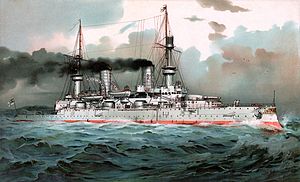 SMS Kaiser Wilhelm II
| |
| Class overview | |
|---|---|
| Builders | |
| Operators | |
| Preceded by | Brandenburg class |
| Succeeded by | Wittelsbach class |
| Built | 1895–1901 |
| In commission | 1898–1920 |
| Completed | 5 |
| Scrapped | 5 |
| General characteristics | |
| Type | Pre-dreadnought battleship |
| Displacement | |
| Length | 125.3 m (411 ft 1 in) o/a |
| Beam | 20.4 m (66 ft 11 in) |
| Draft | 7.89 m (25 ft 11 in) |
| Installed power | |
| Propulsion |
|
| Speed | 17.5 knots (32.4 km/h; 20.1 mph) |
| Range | 3,420 nmi (6,330 km; 3,940 mi) at 10 knots (19 km/h; 12 mph) |
| Complement |
|
| Armament |
|
| Armor |
|
The Kaiser Friedrich III class consisted of five pre-dreadnought battleships of the Imperial German Navy; all ships of the class were named for German emperors. The ships were Kaiser Friedrich III, Kaiser Wilhelm II, Kaiser Wilhelm der Grosse, Kaiser Barbarossa, and Kaiser Karl der Grosse, all built between 1895 and 1901. The class saw the introduction of the traditional armament layout for German battleships prior to the advent of the dreadnought type of battleship in the early 1900s: four large-caliber guns, but of comparatively smaller size compared to their contemporaries, in two gun turrets. The German adoption of smaller guns was a result of a preference for higher volumes of fire over weight of shell. The Kaiser Friedrich III class also standardized the use of three screws for battleships and introduced water-tube boilers and Krupp cemented armor.
On entering service, the ships were assigned to I Squadron, of which Kaiser Friedrich III served as the flagship, while Kaiser Wilhelm II served as the flagship for the overall fleet commander. The ships conducted routine training exercises and cruises in the early 1900s and Kaiser Friedrich III was badly damaged in a grounding accident while steaming in the Baltic Sea in 1901. As newer battleships entered service later in the decade, the ships of the class were moved to II Squadron in 1905 and all of the ships except Kaiser Karl der Grosse were rebuilt between 1907 and 1910. Thereafter they were reduced to reserve status beginning in 1908, since more powerful dreadnought battleships had begun to be commissioned; the rest of their peacetime careers consisted of periodic reactivations to participate in annual fleet training maneuvers.
At the start of World War I in July 1914, the ships were recommissioned and assigned to V Squadron; they were tasked with coastal defense in the North Sea but were quickly transferred to the Baltic to support German operations against the Russian Empire. They saw limited activity during this period, and they returned to the North Sea for guard duties in early 1915. The increasing threat of modern weapons, particularly the British submarines that had begun to operate in the area, combined with shortages of crews for more valuable vessels, led the navy to decommission all five members of the class in March 1915. They were used in a variety of secondary roles. They were all discarded in the early 1920s as Germany disarmed under the terms of the Treaty of Versailles.